ECU MERCEDES-BENZ METRIS 2021 MY21 Operator's Manual
[x] Cancel search | Manufacturer: MERCEDES-BENZ, Model Year: 2021, Model line: METRIS, Model: MERCEDES-BENZ METRIS 2021Pages: 290, PDF Size: 4.68 MB
Page 121 of 290
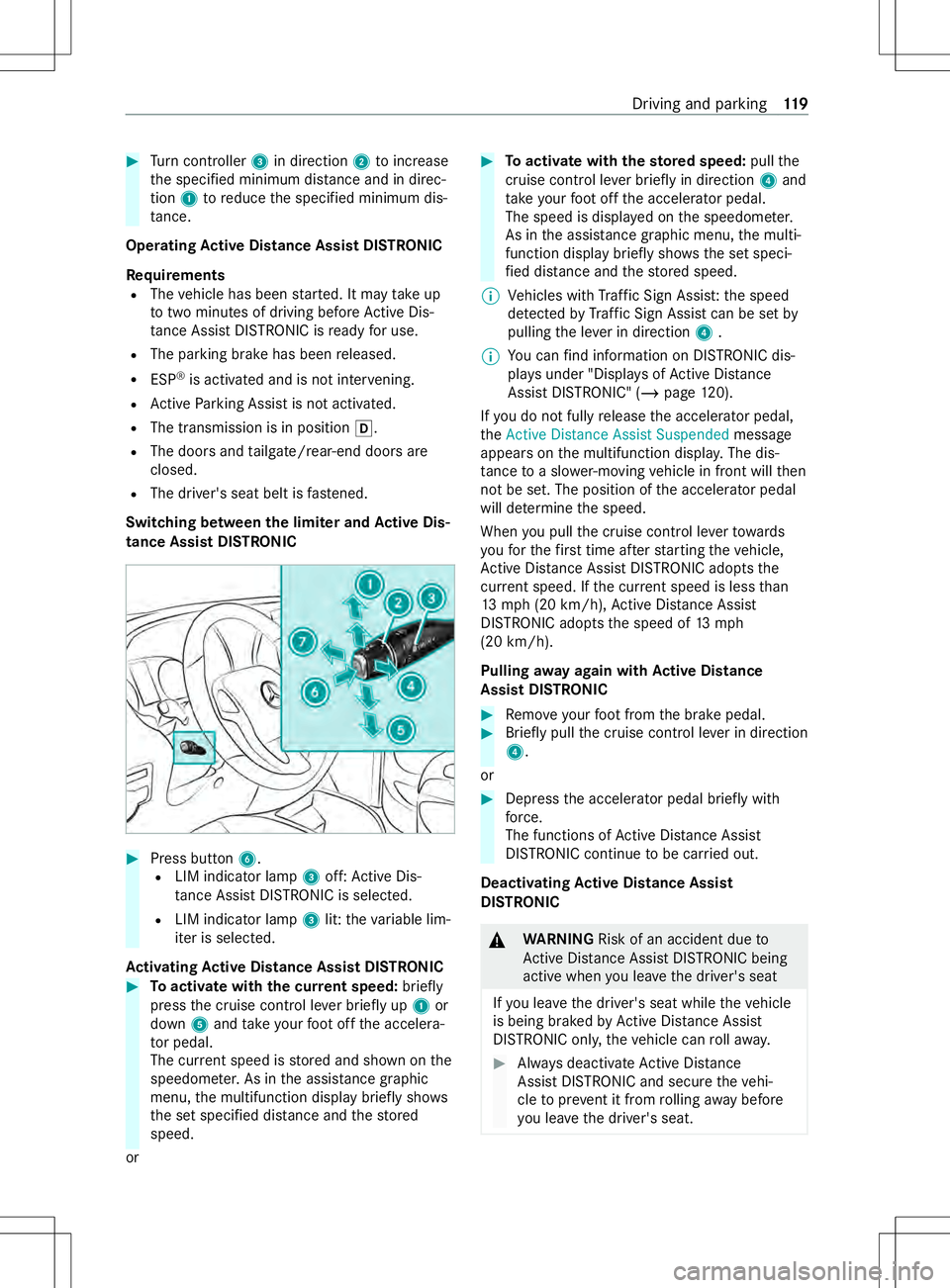
#
Turn controller 3in direction 2toinc rease
th es pecified minimum dis tance and in di rec‐
tion 1toreduce thes pecified minimum dis‐
ta nce.
Ope ratin gA ctive Distance Assis tDISTRONIC
Re quirements
R The vehicle has been star ted. It ma ytakeup
to twom inutesofd riving befor eActiv eDis‐
ta nce Assi stDISTRONI Cisready foru se.
R The parking brak ehas been released.
R ESP ®
is activated and is no tinter vening.
R ActiveP arking Assis tisnotactivated.
R The transmissio nisinposition005B.
R The door sand tailgate/rear-en ddoor sare
closed.
R The driver's seat belt is fastened.
Switching between thel imiter and Activ eD is‐
tanc eAssis tDISTRONIC #
Press but ton6.
R LIM indica torlamp 3off: ActiveD is‐
ta nce Assi stDISTRONI Cisselected.
R LIM indica torlamp 3lit:t he variable lim‐
iter is selec ted.
Ac tivatin gActive Distance Assis tDISTRONIC #
Toactivat ewiththec urrent speed: briefly
press thec ruise cont rolleve rbriefly up 1or
down 5and take your foot offt he accelera‐
to rp edal.
The cur rent speed is stored and shown on the
speedome ter.As in thea ssis tance graphic
menu ,the multifunction displa ybrief ly sho ws
th es etspecified dis tance and thes tored
speed.
or #
Toactivat ewiththes tore ds peed: pullthe
cruise control le verb riefly in direction 4and
ta ke your foot offt he accelera torp edal.
The speed is displa yedont he speedome ter.
As in thea ssis tance graphi cmenu ,the multi‐
function displa ybrief ly sho ws th esetspeci‐
fi ed dis tance and thes tore ds peed.
% Ve
hicles wit hTraffic Sign Assis t:thes peed
de tected byTraf ficS ign Assi stcan be se tby
pulling thel eve rind irection 4.
% Yo
uc an find information on DISTRONIC dis‐
pl ay su nder "Displa ysofActiveD ista nce
Assi stDISTRONIC" (/ page 120).
If yo udon otfull yrelease thea ccelera torp edal,
the Active Distance Assist Suspended message
appear sonthe multifunction displa y.The dis‐
tan cetoas lowe r-moving vehicle in front will then
no tbes et.T he position of thea ccelera torp edal
willd etermine thes peed.
When youp ullthec ruise cont rolleve rtow ards
yo uf or thef irst time af ters tartin gt he vehicle,
Ac tiveD ista nce Assi stDISTRONI Cadoptst he
cur rent speed .Ifthe cur rent speed is less than
13 mp h(20 km/h ),Ac tiveD ista nce Assi st
DISTRONI Cadoptst he speed of 13mph
(20 km/h).
Pulling away again with Activ eD ista nce
Assis tDISTRONIC #
Remo veyour foot from theb rake pedal. #
Brief lypull thec ruise cont rolleve rind irection
4.
or #
Depress thea ccelerator pedal briefly with
fo rc e.
The functions of ActiveD istan ce Assi st
DISTRONI Ccontinue tobe car ried out.
Deactivating Activ eD ista nce Assist
DISTRO NIC &
WARNING Risk of an accident du eto
Ac tiveD istan ce Assi stDISTRONI Cbeing
acti vewhen youl eave thed rive r's seat
If yo ul eave thed rive r's seat while thev ehicle
is being braked byActiveD ista nce Assi st
DISTRONI Conly,the vehicle can rollaw ay. #
Alwaysd eactivat eActiv eDista nce
Assi stDISTRONI Cand secur ethe vehi‐
cle topreve nt it from rolling away before
yo ul eave thed rive r's seat. Driving and parking
11 9
Page 123 of 290
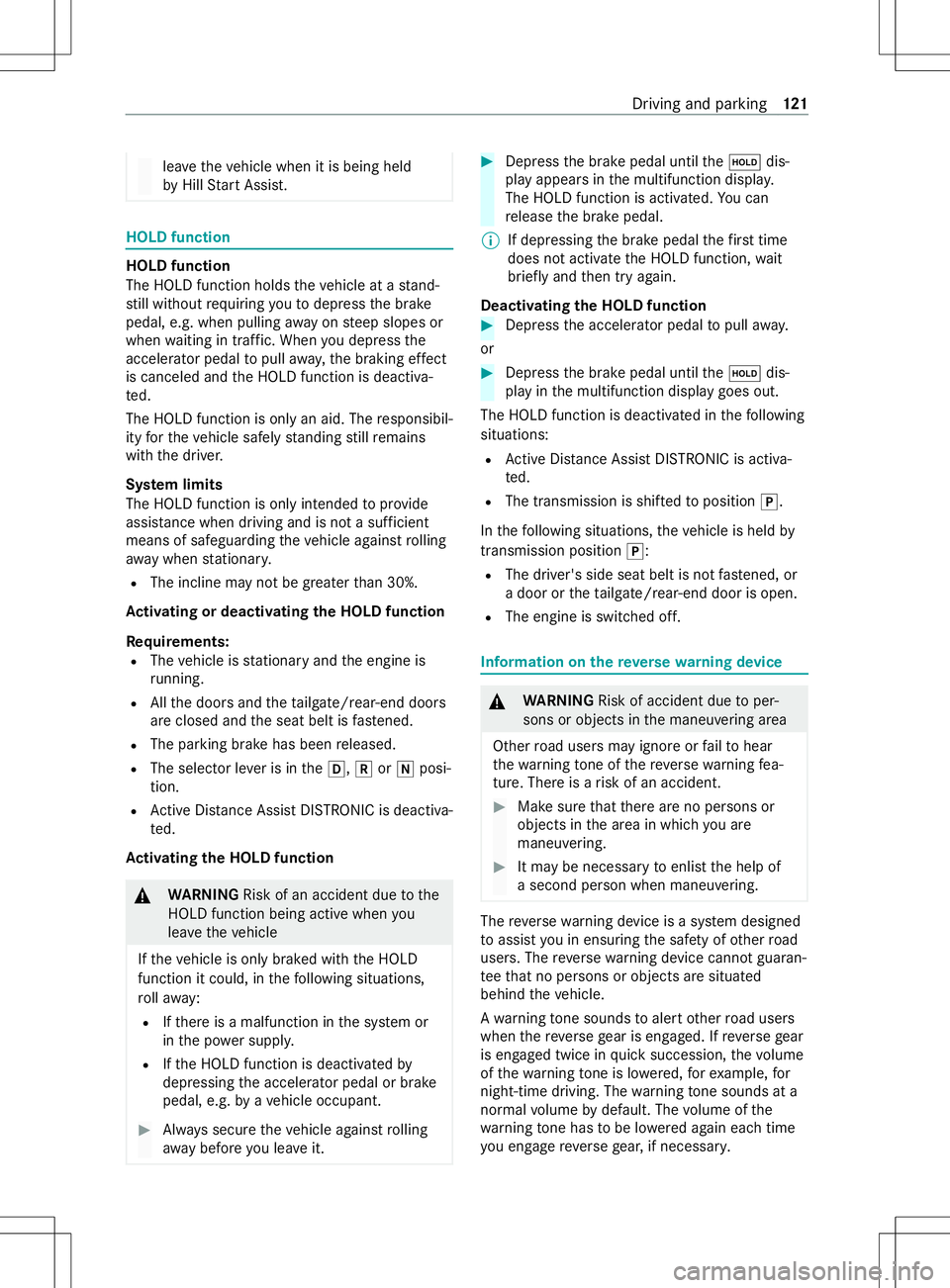
lea
vethev ehicle when it is being held
by Hill StartA ssist. HOLD function
HOLD function
The HOL
Dfunction holds thev ehicle at astand‐
st ill without requ iring youtod epress theb rake
pedal, e.g. when pulling away on steep slopes or
when waitin gint raffic. When youd epress the
accelerator pedal topull away,the braking ef fect
is canceled and theH OLD function is deactiva‐
te d.
The HOLD function is onl yanaid. The responsibil‐
ity fort he vehicle safely standin gstillr emains
wit hthe driver.
Sy stem limits
The HOL Dfunction is onl yintende dtoprovide
assis tance when driving and is no tasufficient
means of safeguarding thev ehicle agains trolling
aw ay when stationar y.
R The incline ma ynotbe greater than 30%.
Ac tivatin gordeactivatin gthe HOL Dfunction
Requ irements:
R The vehicle is stationar yand thee ngine is
ru nning.
R Allthed oor sand thet ailgate/rear-en ddoors
ar ec lose dand thes eat belt is fastened.
R The parking brak ehas been released.
R The selec torleve risint he005B, 005Eor005C posi‐
tion.
R ActiveD istan ce Assi stDISTRONI Cisdeacti va‐
te d.
Ac tivatin gthe HOL Dfunction &
WARNING Risk of an accident du etothe
HOLD function being acti vewhe nyou
lea vethev ehicle
If th ev ehicle is only braked wit hthe HOLD
function it could, in thef ollowing situations,
ro llaw ay:
R Ifth er eisam alfunction in thes ystemor
in thep ower supply.
R Ifth eH OLD function is deactivated by
depressing thea ccelera torp eda lorb rake
pedal, e.g. byavehicle occupant. #
Alwayss ecur ethe vehicle agains trolling
aw ay befor eyou lea veit. #
Depress theb rake pedal until the00D9 dis‐
pla yappear sinthe multifunction displa y.
The HOLD function is activated. Youc an
re lease theb rake pedal.
% If depressing
theb rake pedal thef irst time
does no tactivate theH OLD function, wait
brief lyand then tr yagain.
Deactivating the HOLD function #
Depress thea ccelerator pedal topull away.
or #
Depress theb rake pedal until the00D9 dis‐
pla yint he multifunction displa ygoes out.
The HOLD function is deactivated in thef ollowing
situations:
R ActiveD istan ce Assi stDISTRONI Cisactiva‐
te d.
R The transmission is shif tedtop osition 005D.
In thef ollowing situations, thev ehicle is held by
transmission position 005D:
R The driver' ssides eatb eltisn otfast ened, or
ad oor or thet ailgate/rear-en ddoor is open.
R The engin eisswitched off. Information on
ther eve rsew arnin gdevice &
WARNING Risk of accident du etoper‐
sons or objects in them aneuvering area
Other road user smayignor eorf ailtohear
th ew arning tone of ther eve rsew arning fea‐
ture. Ther eisarisk of an accident. #
Mak esuret hat ther ea reno persons or
object sinthe area in whic hyou are
maneuvering. #
It ma yben ecessar ytoenlistthe help of
as econ dperson when maneuvering. The
reve rsew arning device is asystemd esigned
to assis tyou in ensuring thes afet yofo ther road
users. The reve rsew arning device canno tguaran‐
te et hat no persons or objects ar esituated
behin dthe vehicle.
Aw arning tone sounds toaler tother road users
when ther eve rseg ear is engaged. If reve rseg ear
is engaged twice in quicks uccession ,the volume
of thew arning tone is lo wered, fore xamp le,for
night-tim edriving. The warning tone sounds at a
normal volume bydefault. The volume of the
wa rning tone ha stobel owereda gain eac htime
yo ue ngag ereve rseg ear ,ifn ecessar y. Driving and pa
rking 121
Page 124 of 290
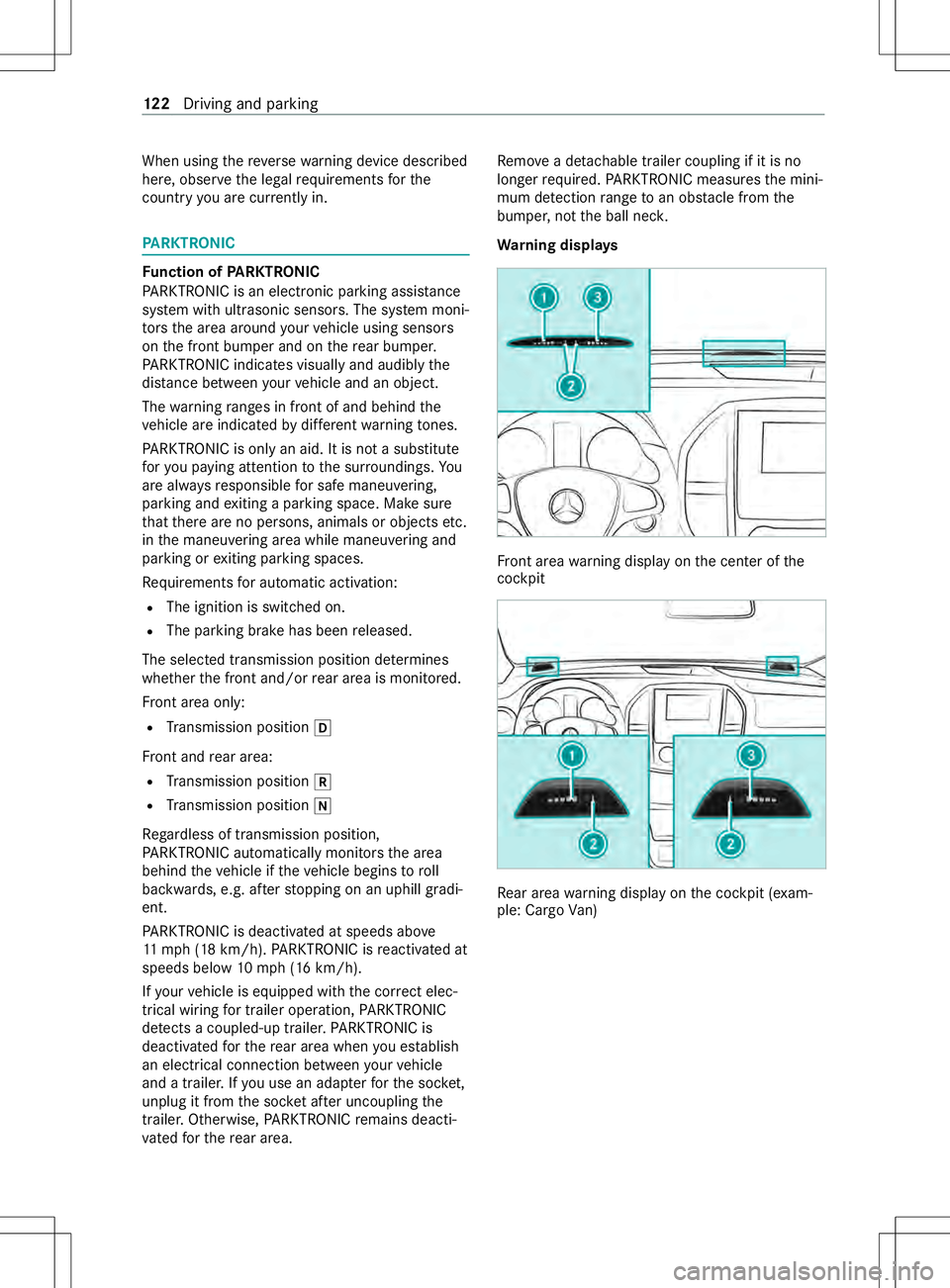
When using
ther eve rsew arning device described
here, obser vethel egal requ irements fort he
countr yyou ar ecurrently in. PA
RKTRONIC Fu
nction of PARKTRONIC
PA RKTRONI Cisanelectronic parkin gassis tance
sy stem wit hultrasonic sensors. The sy stem moni‐
to rs thea reaa round your vehicle using sensors
on thef ront bumper and on ther ear bumper.
PA RKTRONI Cindicates visuall yand audibl ythe
dis tance between your vehicle and an object.
The warning ranges in front of and behind the
ve hicle ar eindicated bydiffere nt wa rning tones.
PA RKTRONI Cisonly an aid. It is no tasubstitute
fo ry ou paying attention tothes urroundings. Yo u
ar ea lway sr esponsibl efor saf emaneu vering,
pa rking and exitin gap arkin gspace. Mak esure
th at ther ea reno persons, animals or object setc.
in them aneuvering area while maneuvering and
parking or exitin gparkin gspaces.
Re quirements fora utomatic activation:
R The ignitio nisswitched on.
R The parking brak ehas been released.
The selec tedt ransmission position de term ines
whe ther thef ront and/or rear area is monitored.
Fr ont area only:
R Transmission position 005B
Fr ont and rear area:
R Transmission position 005E
R Transmission position 005C
Re gardless of transmissio nposition,
PA RKTRONI Cautomatical lymonitor sthe area
behind thev ehicle if thev ehicle begins toroll
backwards, e.g. af ters topping on an uphill gradi‐
ent.
PA RKTRONI Cisdeactivated at speeds abo ve
11 mp h(18 km/h). PARKTRONI Cisreactivated at
speeds belo w10mph (16km/h).
If yo ur vehicle is equipped wit hthe cor rect elec‐
trica lwirin gfor trailer operation ,PARKTRONIC
de tects acoupled-u ptrail er.P ARKTRONIC is
deactivated fort he rear area when youe stablish
an electrical connection between your vehicle
and atrailer .Ify ou use an adap terf or thes ocket,
unplugitf romt he soc keta fter uncoupling the
traile r.Otherwise, PARKTRONI Cremain sdeacti‐
va tedf or ther ear area. Re
mo vead etachable trailer coupling if it is no
lon gerrequired. PARKTRONI Cmeasures them ini‐
mum de tection rang etoano bstacle from the
bumper ,not theb all nec k.
Wa rning displa ys Fr
ont area warning displa yonthe center of the
cockpit Re
ar area warning displa yonthe cockpit (e xam‐
ple: Cargo Van) 12 2
Driving and pa rking
Page 128 of 290
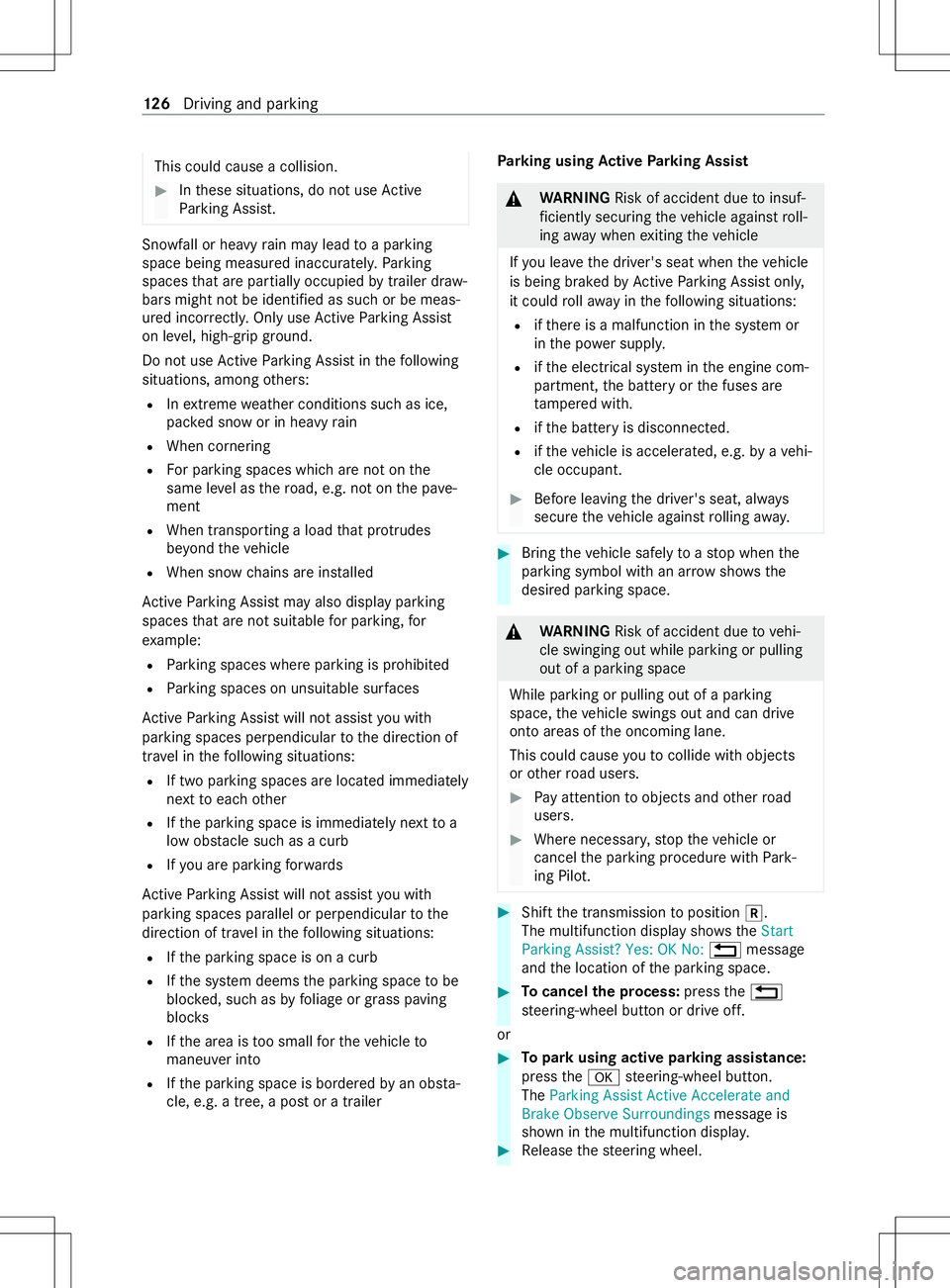
This could cause
acollision. #
Inthese situations, do no tuse Active
Pa rking Assist. Sn
owfa ll or heavy rain ma ylead toap arking
spac ebeingm easured inaccuratel y.Pa rking
spaces that ar epartiall yoccupied bytraile rdraw‐
bar sm ight no tbeidentified as suc horbemeas‐
ured incor rectly .Only use ActiveP arking Assist
on le vel, high-grip ground.
Do no tuse ActiveP arking Assis tinthefollowing
situations ,amon gothers:
R Inextreme weather condition ssuchasi ce,
pac keds noworinh eavyrain
R When cornering
R Forp arking space swhicha renotont he
same le velast heroad, e.g .not on thep ave‐
ment
R When transporting aloa dt hat pr otru des
be yond thev ehicle
R When sno wchains ar einstalled
Ac tiveP arking Assis tmayalso displa yparking
spaces that ar enotsuitable forp arking, for
ex ample:
R Parking spaces wher eparkin gisp rohibited
R Parking spaces on unsuitable sur faces
Ac tiveP arking Assis twill no tassis tyou with
parking spaces perpendicular tothed irection of
tra velint hefollowing situations:
R If tw oparkin gspaces ar elocated immediately
next toeac hother
R Ifth ep arking space is immediatel ynexttoa
lo wo bstacle suc hasac urb
R Ifyo ua reparkin gforwa rds
Ac tiveP arking Assis twill no tassis tyou with
parking spaces parallelorp erpendiculartothe
direction of tra velint hefollowing situations:
R Ifth ep arking space is on acurb
R Ifth es ystemd eems thep arking space tobe
bloc ked, suc hasbyf oliageorg rass paving
bloc ks
R Ifth ea reaist oo small fort he vehicle to
maneuver into
R Ifth ep arking space is bordered byan obs ta‐
cle, e.g. atree, ap ostora trailer Park
ing using Activ eP arkin gAssist &
WARNING Risk of accident du etoinsuf‐
fi ciently secu ring thev ehicle agains troll‐
ing away when exitin gthe vehicle
If yo ul eave thed rive r's seat when thev ehicle
is being braked byActiveP arking Assis tonly,
it could rollaw ay inthef ollowing situations:
R ifth er eisam alfunction in thes ystemor
in thep owe rsupply.
R ifth ee lectrical sy stem in thee ngine com‐
partment, theb atter yort he fuses are
ta mp ered with.
R ifth eb atter yisd isconnected.
R ifth ev ehicle is accelerated, e.g. byavehi‐
cle occupant. #
Befor eleaving thed rive r's seat, alw ays
secur ethe vehicle agains trolling away. #
Bring thev ehicle safel ytoastopw hen the
parking symbol wit hanarrow sho ws the
desired parking space. &
WARNING Risk of accident du etovehi‐
cle swinging out while parking or pulling
out of aparking space
While parking or pulling out of aparking
space, thev ehicle swings out and can drive
ont oareas of theo ncoming lane.
This could cause youtoc ollide wi thobjects
or other road users. #
Paya ttention toobject sand other road
users. #
Wher enecessar y,stop thev ehicle or
cancel thep arking procedur ewithP ark‐
ing Pilot. #
Shif tthe transmission toposition 005E.
The multifunction displa yshows the Start
Parking Assist ?Yes: OK No: ~message
and thel ocation of thep arking space. #
Tocancel thep rocess: pressthe~
st eering-wheel button or driv eoff.
or #
Topar kusing acti veparkin gassistance:
press the0076 steering-wheel button.
The Parking Assist Active Accelerate and
Brake Observe Surroundings messageis
shown in them ultifunction displa y. #
Release thes teering wheel. 12 6
Driving and pa rking
Page 133 of 290
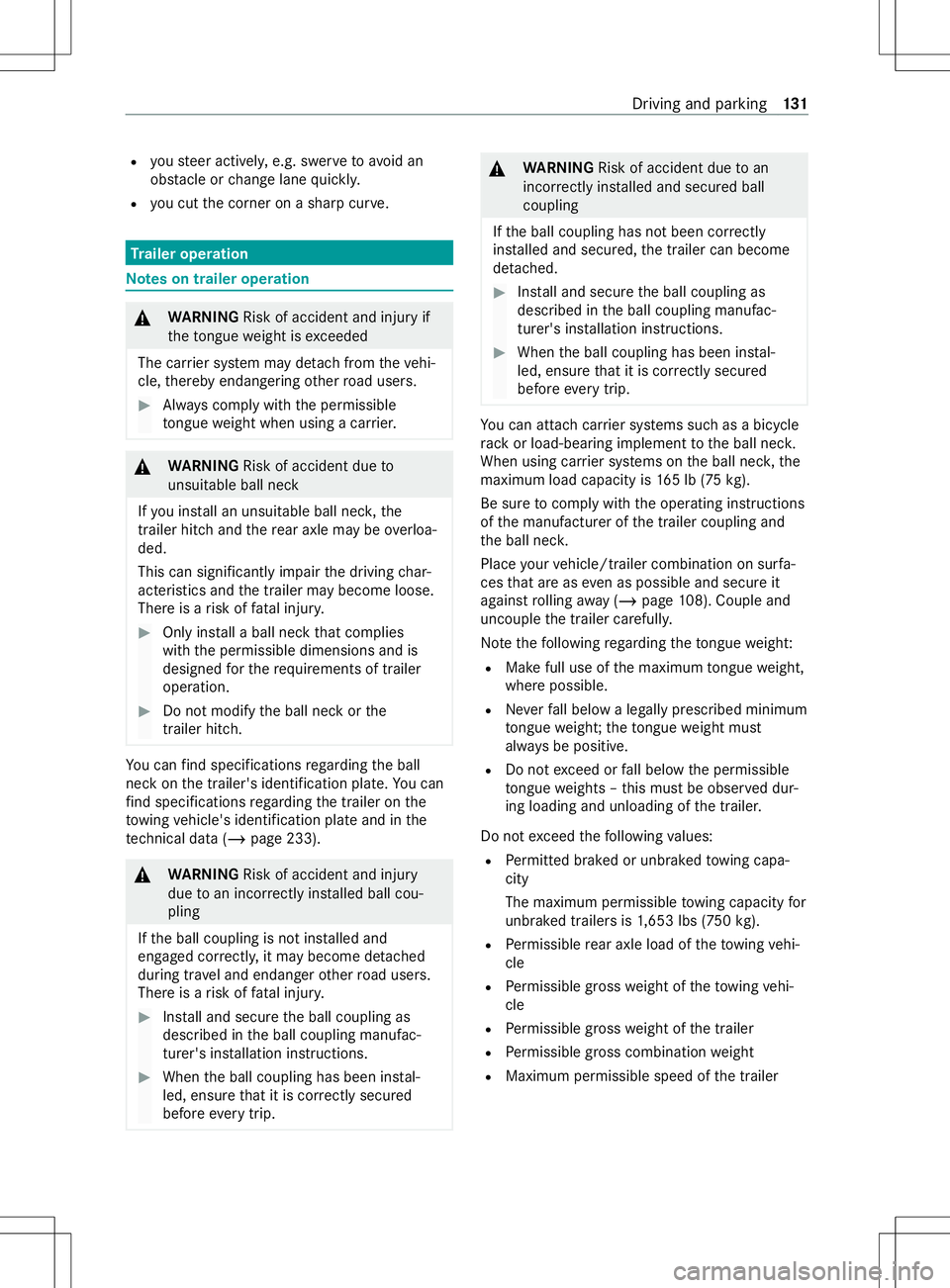
R
yous teer actively ,e.g. swer vetoavoid an
obs tacle or chang elane quickl y.
R youc utthec orner on ashar pcurve. Tr
aile roperation Note
sont railer operation &
WARNING Risk of accident and inju ryif
th et ongue weight is exceeded
The car rier sy stem ma ydetac hf romt hevehi‐
cle, thereb yendangering other road users. #
Alwaysc ompl ywitht he permissible
to ngu eweight when using acarrier. &
WARNING Risk of accident du eto
unsuitable ball neck
If yo ui nstall an unsuitable ball nec k,the
traile rhitch and ther ear axle ma ybeoverloa‐
ded.
This can significantl yimp air thed riving char‐
acteristic sand thet railer ma ybecome loose.
Ther eisar isk offata linjur y. #
Only ins tallab all nec kthat complies
wit hthe permissible dimensions and is
designed fort he requ irements of trailer
operation. #
Do no tmodif ythe ball nec korthe
trailer hitch. Yo
uc an find specifications rega rding theb all
nec kont he trailer's identification plate. Youc an
fi nd specifications rega rding thet railer on the
to wing vehicle's identification plat eand in the
te ch nica ldata( /pag e233). &
WARNING Risk of accident and inju ry
due toan incor rectly ins talled ball cou‐
pling
If th eb all coupling is no tins talled and
engaged cor rectl y,it ma ybecom edetached
during tra vela nd endan gero ther road users.
Ther eisar isk offata linjur y. #
Install and secur ethe ball coupling as
described in theb all coupling manufac‐
turer's ins tallation instructions. #
When theb all coupling has been ins tal‐
led, ensur ethat it is cor rectly secu red
befor eevery trip. &
WARNING Risk of accident du etoan
incor rectl yins tal led and secured ball
coupling
If th eb all coupling has no tbeen cor rectly
ins talled and secured, thet railer can become
de tach ed. #
Install and secur ethe ball coupling as
described in theb all coupling manufac‐
turer's ins tallation instructions. #
When theb all coupling has been ins tal‐
led, ensur ethat it is cor rectly secu red
befor eevery trip. Yo
uc an attac hcarrier sy stems suc hasabicycle
ra ck or load-bearing implement totheb all nec k.
When using car rier sy stems on theb all nec k,the
maximu mloadc apacity is 165lb( 75kg).
Be sur etocomply wi th theoperating instructions
of them anufacturer of thet railer coupling and
th eb all nec k.
Place your vehicle/trailer combination on sur fa‐
ces that ar ease vena spossible and secu reit
agains trolling away ( /pag e108). Coupl eand
uncoupl ethe trailer carefully.
No tethef ollowing rega rding thet ongue weight:
R Mak efull use of them aximum tongu eweight,
wher epossible.
R Neverfall belo walegally prescribed minimum
to ngu eweight ;the tongu eweight must
alw aysbep ositive.
R Do no texceed or fall belo wthe permissible
to ngu eweights –this mus tbeobservedd ur‐
ing loading and unloading of thet railer.
Do no texceed thef ollowing values:
R Perm itted braked or unbraked towing capa‐
city
The maximum permissible towing capacity for
unbraked trailer sis1,653 lbs (750 kg).
R Perm issible rear axle load of thet ow ing vehi‐
cle
R Perm issible gross weight of thet ow ing vehi‐
cle
R Perm issible grossweight of thet railer
R Perm issible grosscombination weight
R Maximum permissible speed of thet railer Driving and parking
131
Page 134 of 290
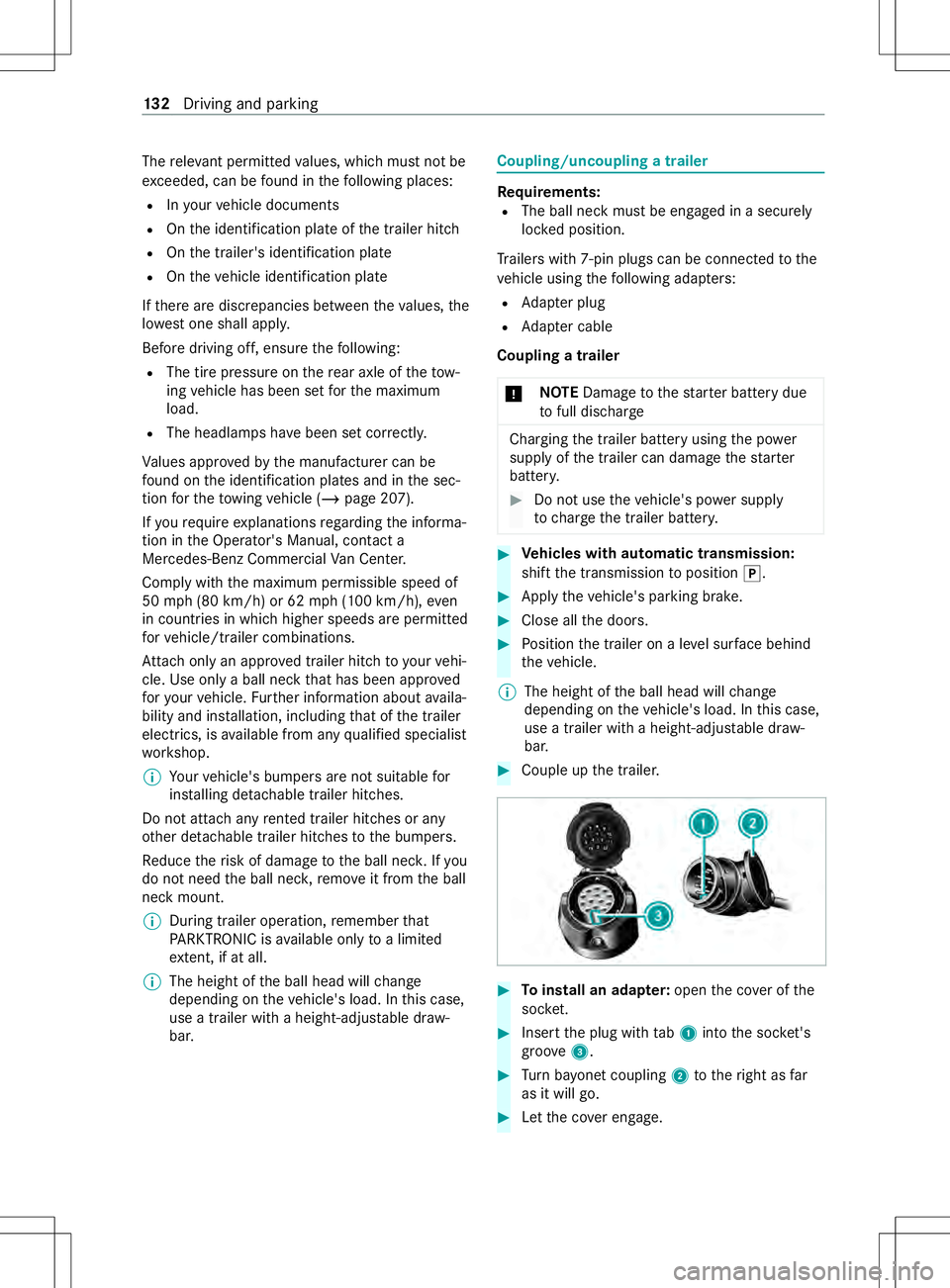
The
releva nt pe rmitted values, whic hmustn otbe
exc eeded, can be found in thef ollowing places:
R Inyour vehicle documents
R Onthei dentification plat eofthe trailer hitch
R Onthet railer's identification plate
R Onthev ehicle identification plate
If th er ea rediscrepancies between thev alues, the
lo we stone shall appl y.
Befor edriving off, ensu rethef ollowing:
R The tir epressur eont herear axle of thet ow‐
ing vehicle has been se tfor them aximum
load.
R The headlamps ha vebeen se tcorrectly.
Va lues appr oved bythem anufacturer can be
fo und on thei dentification plates and in thes ec‐
tion fort he towing vehicle (/ page207).
If yo ur equir eexplanations rega rding thei nforma‐
tion in theO perator's Manual, contact a
Mercedes-Benz Commercial VanC enter.
Co mp ly wi th th emaximum permissible speed of
50 mph(80 km/h) or 62 mph(100k m/h), even
in countries in whic hhigher speeds ar epermit ted
fo rv ehicle/trailer combinations.
At tach onl yana pprove dtrailer hitc htoyourvehi‐
cle. Use onl yaball nec kthat has been appr oved
fo ry our vehicle. Further information about availa‐
bilit yand ins tallation ,including that of thet railer
electrics, is available from an yqualified specialist
wo rkshop.
% Yo
ur vehicle's bumper sarenots uitable for
ins talling de tach able trailer hit ches.
Do no tattac hanyrented traile rhitch es or any
ot her de tach able trailer hit ches totheb umpers.
Re duce ther isk of damag etothe ball nec k.Ifyou
do no tneed theb all nec k, removeit from theb all
nec km ount.
% During trailer operation,
remember that
PA RKTRONI Cisavailable onl ytoalimited
ex tent, if at all.
% The height of
theb all head will change
depending on thev ehicle's load. In this case,
use atrailer wit haheight-adjus table dr aw‐
bar. Coupling/uncoupling
atrailer Re
quirements:
R The ball nec kmustbee ngaged in asecurely
loc kedp osition.
Tr ailer swith7 -pin plugs can be connec tedtot he
ve hicle using thef ollowing adap ters:
R Adapterp lug
R Adapterc able
Coupling atrailer
* NO
TEDama getothes tarter batter ydue
to full discharge Charging
thet railer batter yusing thep ower
supply of thet railer can damag ethe star ter
batter y. #
Do no tuse thev ehicle's po wersupply
to charge thet railer batter y. #
Vehicles with automatic transmission:
shif tthe transmission toposition 005D. #
Appl ythe vehicle's parking brake. #
Close all thed oors. #
Position thet railer on alevel sur face behind
th ev ehicle.
% The height of
theb all head will change
depending on thev ehicle's load. In this case,
use atrailer wit haheight-adjus table dr aw‐
bar. #
Couple up thet railer. #
Toinstall an ada pter: open thec ove roft he
soc ket. #
Inse rtthep lug wit htab 1 intot he soc ket's
groo ve3 . #
Turn bayone tc oupling 2tother ight as far
as it will go. #
Letthe co vere ngage. 13 2
Driving and pa rking
Page 135 of 290
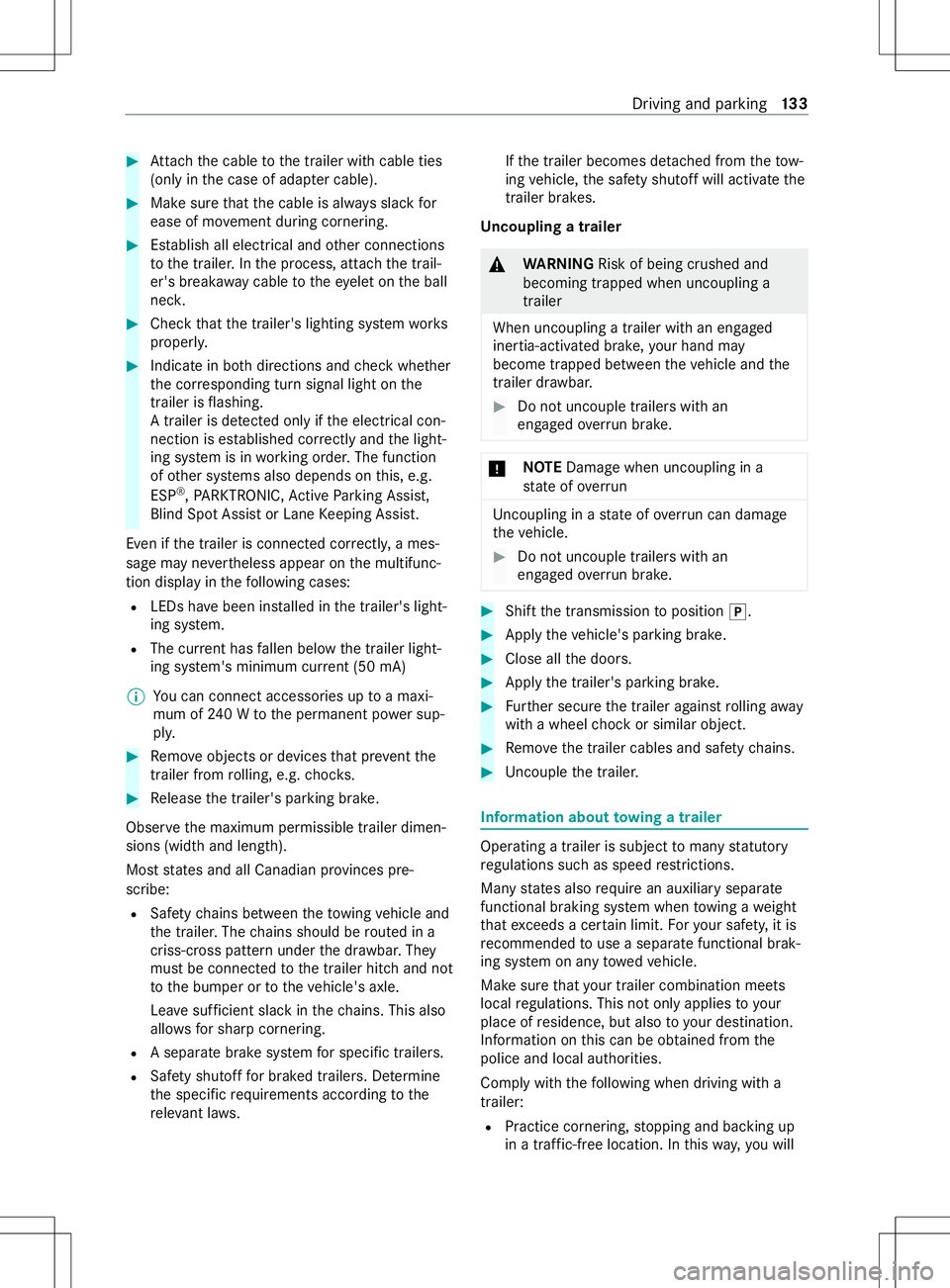
#
Attach thec able tothet railer wit hcable ties
(onl yint he case of adap terc able). #
Mak esuret hat thec able is alw ayss lac kfor
ease of mo vement during cornering. #
Establish all electrical and other connections
to thet railer .Inthe process, attac hthe trail‐
er's break away cable tothee yeletont he ball
nec k. #
Chec kthat thet railer's lighting sy stem works
properly. #
Indicat einbothd irections and checkw hether
th ec orresponding tur nsignal light on the
traile risflashing.
At railer is de tected only if thee lectrical con‐
nection is es tablished cor rectl ya nd thel ight‐
ing sy stem is in working order .The function
of other sy stems also depends on this, e.g.
ESP ®
,P ARKTRONIC, ActiveP arking Assist,
Blin dSpotA ssis torL aneKeeping Assist.
Even if thet railer is connected cor rectly ,am es‐
sag em aynevertheless appear on them ultifunc‐
tion displa yinthefollowing cases:
R LED shave been ins talled in thet railer's light‐
ing sy stem.
R The cur rent ha sfallen belo wthe trailer light‐
ing sy stem's minimum cur rent (50 mA)
% Yo
uc an connec taccesso ries up toam axi‐
mum of 240Wtot he permanent po wersup‐
ply. #
Remo veobject sordevices that pr event the
traile rfromr olling, e.g. choc ks. #
Release thet railer's parking brake.
Obser vethem aximum permissible trailer dimen‐
sions (widt hand length).
Mos tstatesa nd all Canadian pr ovinces pre‐
scribe:
R Safetyc hains between thet ow ing vehicle and
th et railer .The chains shoul dberouted in a
criss-cross patter nunde rthe dr awbar .They
mus tbec onnected tothet railer hitc hand not
to theb umper or tothev ehicle's axle.
Lea vesuf ficient sla ckinthec hains. This also
allo wsfors har pcornering.
R Asepa rate brak esystemf or speci fict railers.
R Safetys hutof ffor braked trailers. De term ine
th es pecific requirements acco rding tothe
re leva nt la ws. If
th et railer becomes de tach ed from thet ow‐
ing vehicle, thes afet ys hutof fwill activat ethe
trailer brakes.
Un coupling atrailer &
WARNING Risk of being crushed and
becoming trapped whe nuncoupling a
trailer
Whe nuncoupling atrailer wi than engaged
ine rtia-activated brake, your han dmay
become trapped between thev ehicle and the
traile rdrawbar. #
Do no tuncouple trailer swithan
engaged overrun brake. *
NO
TEDama gewhen uncouplin gina
st at eofo verrun Uncou
pling in astate ofoverru nc an damage
th ev ehicle. #
Do no tuncouple trailer swithan
engaged overrun brake. #
Shif tthe transmission toposition 005D. #
Appl ythe vehicle's parking brake. #
Close all thed oors. #
Appl ythe trailer's parking brake. #
Further secur ethe trailer agains trolling away
wit haw heelchoc kors imilar object. #
Remo vethet railer cables and saf etyc hains. #
Uncouple thet railer. Information about
towing atrailer Operatin
gatrailer is subject toman ystatutory
re gulations suc hasspeedrestrictions.
Man ystatesa lso requ ireana uxiliaryseparate
functional brakin gsystem when towing aweight
th at exc eeds acertain limit .For your saf ety, it is
re commended touse aseparat efunctional brak‐
ing sy stem on an ytowe dvehicle.
Mak esuret hat your trailer combinatio nmeets
local regulations. This no tonlya pplies to your
plac eofr esidence, but also to your destination.
In fo rm atio nont his can be obtained from the
police and local authorities.
Compl ywitht he following when driving wit ha
trailer:
R Practice cornering, stopping and backing up
in at raffic-free location. In this wa y,yo uw ill Drivin
gand parking 13 3
Page 136 of 290
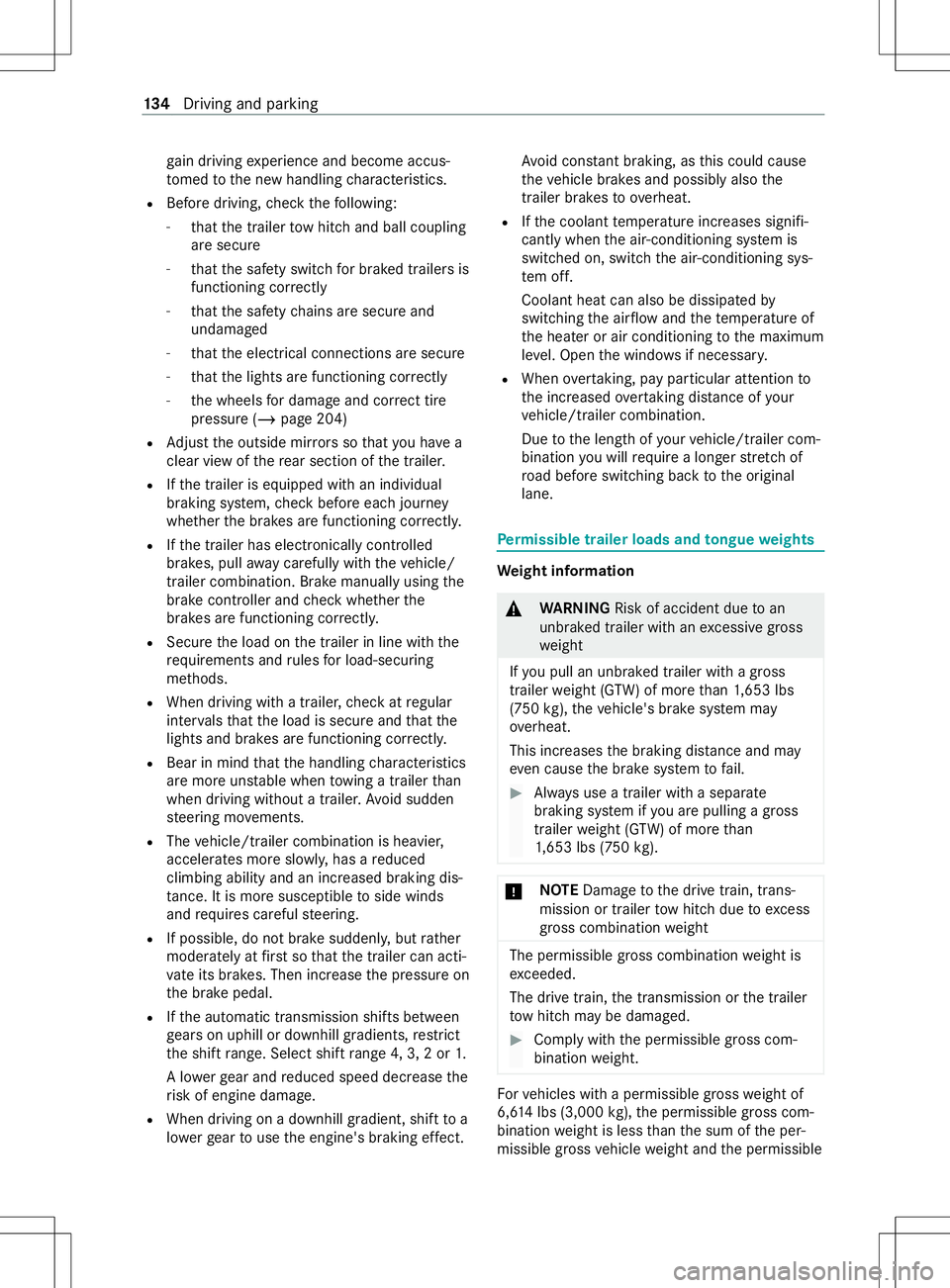
ga
in driving experience and become accus‐
to med tothen ew handling characteristics.
R Befor edriving, checkt he following:
- that thet railer towh itch and ball coupling
ar es ecure
- that thes afet ys wit ch forb rake dt railer sis
functioning cor rectly
- that thes afet yc hains ar esecur eand
undamaged
- that thee lectrical connection saresecure
- that thel ights ar efunctioning cor rectly
- thew heels ford ama geand cor rect tire
pressur e(/ page 204)
R Adjus tthe outside mir rors so that youh ave a
clea rviewoft herear sectio nofthe trailer.
R Ifth et railer is equipped wit hanindividual
braking sy stem, checkb efor eeachj ourney
whe ther theb rake sa refunctioning cor rectl y.
R Ifth et railer has electronicall ycont rolled
brakes, pull away carefully wi th thevehicle/
trailer combination .Brake manually using the
brak econtroller and checkw hether the
brakes ar efunctioning cor rectl y.
R Secu rethel oad on thet railer in line wit hthe
re qu irements and rules forl oad-securing
me thods.
R When driving wit hatrailer ,chec katr egular
inter vals that thel oad is secur eand that the
light sand brakes ar efunctioning cor rectl y.
R Bea rinm indthat theh andling characteristics
ar em oreu nstable when towing atrailer than
when drivin gwithout atrailer .Avoid sudden
st eering mo vements.
R The vehicle/trailer combination is heavier,
accelerates mor eslowl y,has areduced
climbing ability and an increased braking dis‐
ta nce. It is mor esusceptible toside winds
and requ ires careful steering.
R If possible, do no tbrake suddenl y,but rath er
moderatel yatfirst so that thet railer can acti‐
va te its brakes. Then inc rease thep ressur eon
th eb rake pedal.
R Ifth ea utomatic transmission shifts between
ge arsonu phill or downhill gradients, restrict
th es hiftrange. Select shif trang e4,3,2or1.
Al owe rgear and reduced speed decrease the
ri sk of engine damage.
R When driving on adownhill gradient, shif ttoa
lo we rgear touse thee ngine' sbraking ef fect. Av
oid cons tant braking, as this could cause
th ev ehicle brakes and possibly also the
traile rbrake stoo verheat.
R Ifth ec oolant temp eratur eincreases signifi‐
cant lywhen thea ir-conditionin gsystemis
switched on, switc hthe air-conditioning sys‐
te mo ff.
Coolant heat can also be dissipated by
switching thea irflow and thet emperatur eof
th eh eater or air conditioning tothem aximum
le ve l. Open thew indo wsif necessar y.
R When overtak ing, pa yparticular attention to
th ei ncreased overtakin gdista nce of your
ve hicle/trailer combination.
Due tothel engt hofy ourvehicle/trailer com‐
bination youw illrequ ireal onger stre tchof
ro ad befor eswit ching bac ktothe original
lane. Pe
rm issible trailer loads and tongue weights We
ight information &
WARNING Risk of accident du etoan
unbraked trailer wit hanexcessiv egross
we ight
If yo up ull an unbraked trailer wit hagross
tr ailer weight (G TW)ofm oret han 1,653 lbs
(750 kg),th ev ehicle's brak esystem may
ove rheat.
This increases theb raking dis tance and may
eve ncause theb rake system tofail. #
Alwaysu seatrailer wit haseparate
braking sy stem if youa repullin gagross
trailer weight (G TW)ofm oret han
1, 653 lbs (750 kg). *
NO
TEDama getothed rive train, trans‐
mission or trailer towh itch due toexc ess
gross combination weight The permissible
grosscombination weight is
exc eeded.
The driv etrain, thet ransmission or thet railer
to wh itch ma ybed amaged. #
Compl ywitht he permissible gross com‐
bination weight. Fo
rv ehicles wit hapermissible gross weight of
6,6 14 lbs (3,00 0kg),thep ermissible gross com‐
bination weight is less than thes um of thep er‐
missible gross vehicle weight and thep ermissible 134
Driving and pa rking
Page 139 of 290
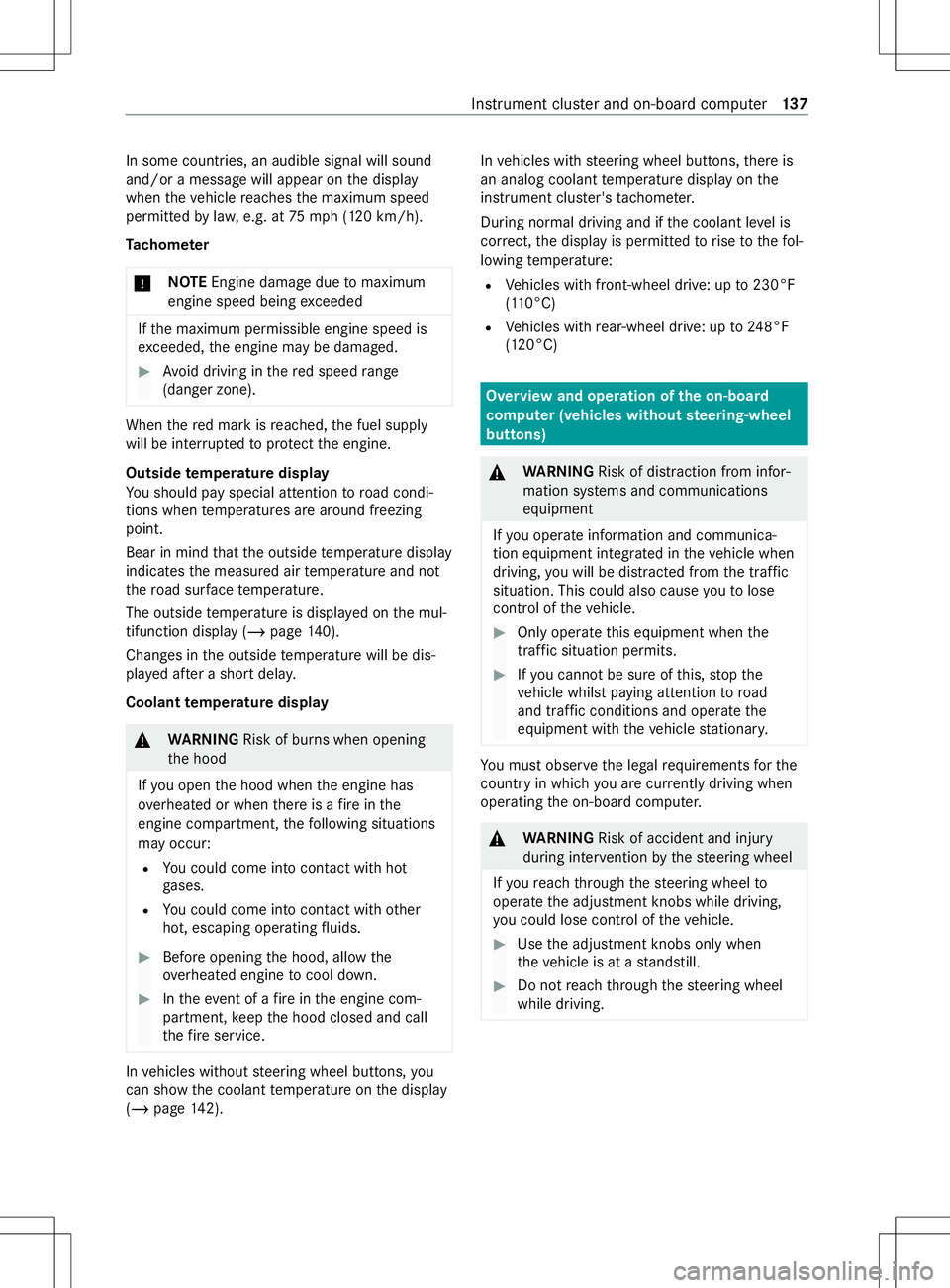
In some countries, an audible signal wills
ound
and/or amessag ewilla ppear on thed isplay
when thev ehicle reaches them aximum speed
permitted bylaw, e.g. at 75mph(120k m/h).
Ta ch ome ter
* NO
TEEngine damag eduetomaximum
engine speed being exceeded If
th em aximum permissible engine speed is
exc eeded, thee ngine ma ybedamaged. #
Avoid driving in ther ed speed range
(danger zone). Whe
nthe redm arkisr eached, thef uel supply
will be inter rupte dtop rotect thee ngine.
Outsid etem peratu re display
Yo us houl dpayspecial attention toroad condi‐
tions when temp eratures ar earound freezing
point.
Bear in mind that theo utside temp eratur edisplay
indicates them easured air temp eratur eand not
th er oad sur face temp erature.
The outside temp eratur eisdisplayedont he mul‐
tifunction displa y(/pag e140).
Changes in theo utside temp eratur ewill be dis‐
pla yeda fter as hor tdela y.
Coolant temperatur edisplay &
WARNING Risk of bu rnsw hen opening
th eh ood
If yo uo pen theh ood when thee ngine has
ov erheated or when ther eisaf ireint he
engine compartment, thef ollowing situations
ma yoccur:
R Youc oul dc om eintoc ontact wi thhot
ga ses.
R Youc oul dc om eintoc ontact wi thother
hot, escaping operating fluids. #
Befor eopening theh ood, allo wthe
ove rheated engine tocool down. #
Inthee vent of afireint he engine com‐
partment, keep theh ood closed and call
th ef ires ervice. In
vehicles without steering wheel buttons, you
can sho wthe coolant temp eratur eonthe display
(/ page142). In
vehicles wit hsteering wheel buttons, ther eis
an analog coolant temp eratur edispla yont he
instrument clus ter's tach ome ter.
During norma ldriving and if thec oolant le velis
cor rect, thed ispla yisp ermitted torise tothef ol‐
lowing temp erature:
R Vehicles wit hfront-wheel drive: up to230°F
(1 10 °C)
R Vehicles wit hrear-wheel drive: up to248°F
(120°C) Overvie
wand operation of theo n-boa rd
compu ter( ve hicles without steering-wheel
but tons) &
WARNING Risk of distraction from infor‐
mation sy stems and communications
equipment
If yo uo perat einformation and communica‐
tio ne quipment integrated in thev ehicle when
driving, youw ill be distracted from thet raffic
situation. This could also cause youtol ose
control of thev ehicle. #
Onlyoperat ethis equipment when the
traf fics ituation permits. #
Ifyo uc anno tbes ureoft his,stop the
ve hicle whils tpaying attention toroad
and traf ficc onditions and ope rate the
equipment wit hthe vehicle stationar y. Yo
um usto bse rvet he legal requirements fort he
countr yinwhich youa recur rentl yd riving when
ope rating theo n-boar dcomputer. &
WARNING Risk of accident and injury
du ring inter vention bythes teering wheel
If yo ur eac hthrough thes teering wheel to
operat ethe adjustment knobs while driving,
yo uc oul dlose control of thev ehicle. #
Use thea djustmen tknobs onl ywhen
th ev ehicle is at astandstill. #
Do no treac hthrough thes teering wheel
while driving. Instrument clus
tera nd on-boar dcomputer 137
Page 140 of 290
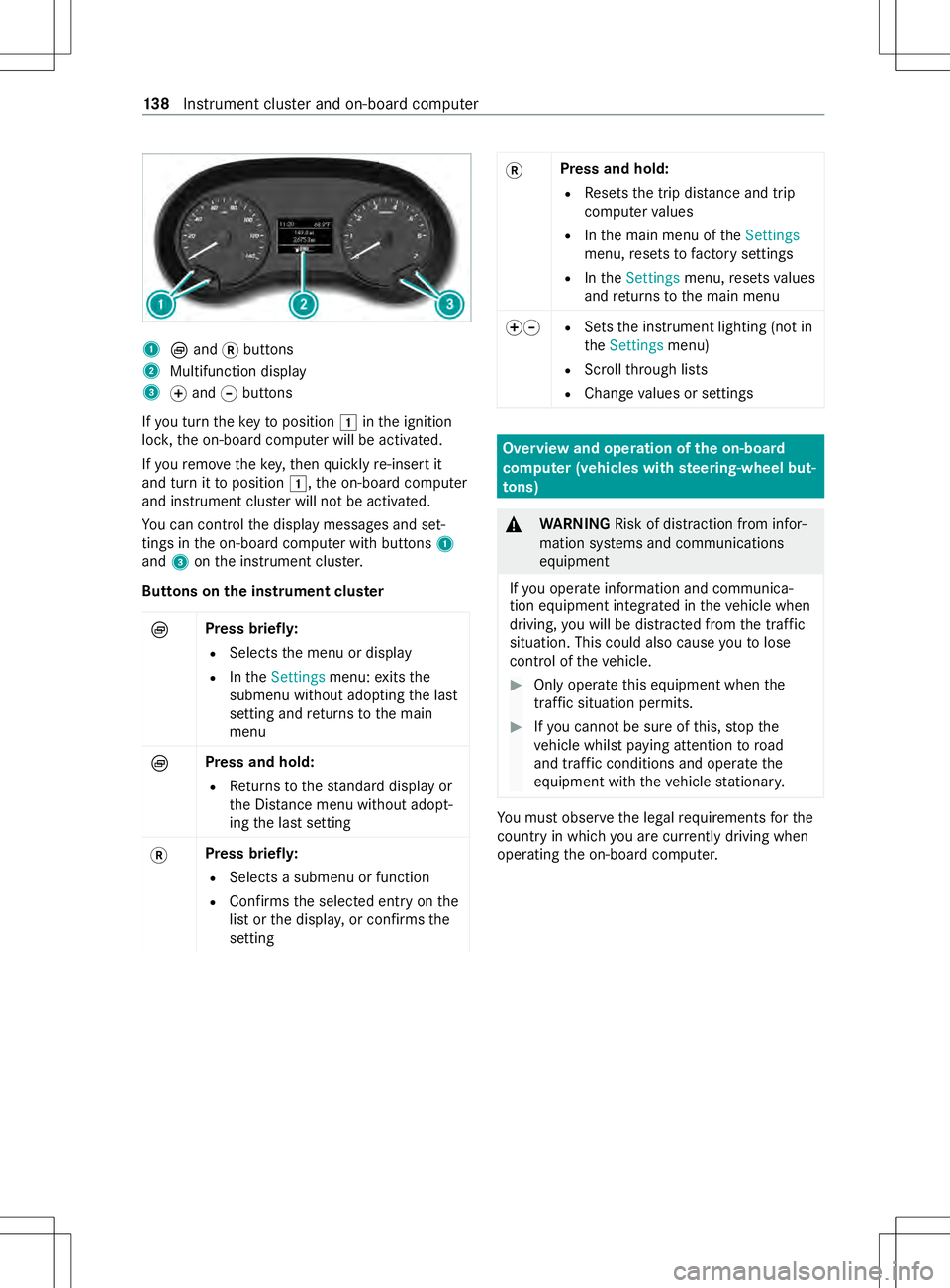
1
Èand 0078buttons
2 Multifunction display
3 0074and 0075buttons
If yo ut urnt he keytop osition 0047inthei gnition
loc k,theo n-boar dcomputer will be activated.
If yo ur emo vethek ey,then quickl yre-inser tit
and tur nittop osition0047,the on-boar dcomputer
and instrument clus terw illn ot be activated.
Yo uc an control thed ispla ymessages and set‐
tings in theo n-boar dcomputer wit hbuttons 1
and 3onthei nstrument clus ter.
Button sonthe instrumen tclust er
È Press brief
ly:
R Selects them enu or display
R Inthe Settings menu:exits the
submenu without adopting thel ast
setting and returns tothem ain
menu
È Press and hold:
R Returns tothes tanda rddispla yor
th eD ista nce menu wi thout adopt‐
ing thel asts etting
0078 Press briefl
y:
R Selects asubmenu or function
R Confirms thes elected entry onthe
lis tort he displa y,or confirms the
setting 0078
Press and hold:
R Resets thet ripd ista nce and trip
computer values
R Inthem ain menu of theSettings
menu, resets tofactor ysettings
R Inthe Settings menu,resets values
and returns tothem ain menu
00740075 R
Sets thei nstrument lighting (no tin
the Settings menu)
R Scroll thro ugh lists
R Chan gevalues or settings Overvie
wand operation of theo n-boa rd
compu ter( ve hicles with steering-wheel but‐
to ns) &
WARNING Risk of distraction from infor‐
mation sy stems and communications
equipment
If yo uo perat einformation and communica‐
tio ne quipment integ ratedint hevehicle when
driving, youw ill be distracted from thet raffic
situation. This could also cause youtol ose
control of thev ehicle. #
Onlyoperat ethis equipment when the
traf fics ituation permits. #
Ifyo uc anno tbes ureoft his,stop the
ve hicle whils tpaying attention toroad
and traf ficc onditions and ope rate the
equipment wit hthe vehicle stationar y. Yo
um usto bse rvet he legal requirements fort he
countr yinwhich youa recur rentl yd riving when
ope rating theo n-boar dcomputer. 13 8
Instrument clus tera nd on-boar dcomputer